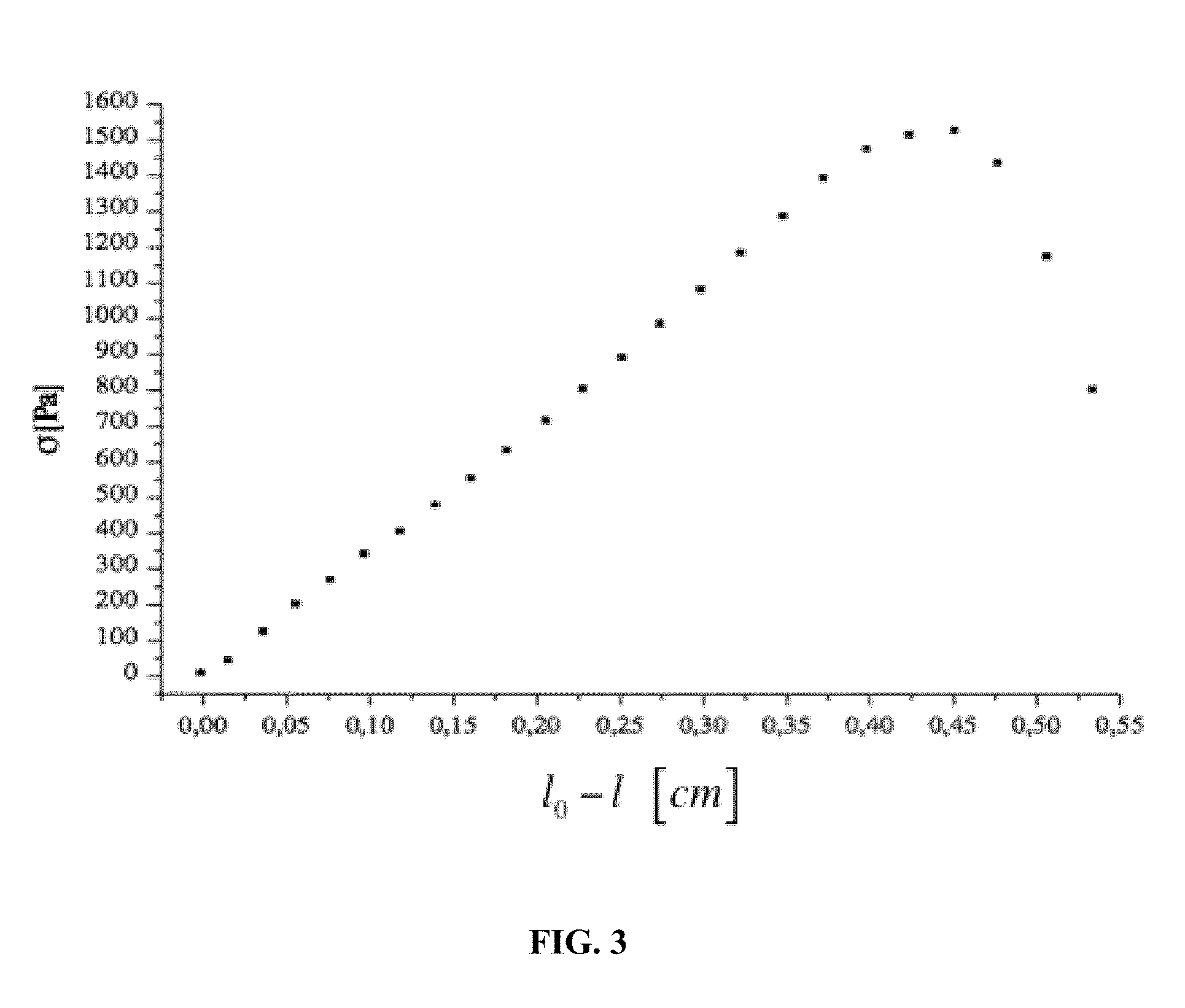Method for producing hydrogels
a hydrogel and hydrogel technology, applied in the field of hydrogel production, can solve the problems of product not suitable for oral administration, product based on methylcellulose and hydroxypropylmethylcellulose (hpmc) is not recommended for use, etc., and achieves mechanical stability and significant water absorption properties.
- Summary
- Abstract
- Description
- Claims
- Application Information
AI Technical Summary
Benefits of technology
Problems solved by technology
Method used
Image
Examples
example 1
Preparation of Citric Acid Cross-Linked Carboxymethylcellulose
[0105]
MaterialsNaCMCE&V, catalog number 72537 - 7H3SXFCitric AcidSigma, catalog number 43309268Purified waterChimica D'Agostino (Bari - Italy)
Method
[0106]Purified water (10 kg) was added to a 10 liter Hobart mixer and agitated at 30 rpm. Citric acid (1.8 g) was added to the water and dissolved. NaCMC (600 g) was then added to the solution and the resulting mixture was agitated at room temperature at 60 rpm for 90 minutes and then at 30 rpm for 15 hours. The resulting solution was added to 10 stainless steel trays (1.030 kg solution per tray). The trays were placed in a Salvis Thermocenter TC240 oven at 45° C. for 24 hours. The trays were removed from the oven, the contents were inverted and the trays were placed back in the oven and maintained at 45° C. for 30 hours. After the desiccation the material was ground by means of a cutting mill (Retsch cutting mill) equipped with a 1 mm screen. The granulated material was then ...
example 2
Study of the Effect of Washing Procedure on the Properties of Citric Acid Cross-Linked Carboxymethylcellulose
[0111]The samples were prepared according to the procedure described in Example 1 with the exception of the washing procedure. In this preparation the sample was divided into 4 mparts, each of which was washed with distilled water 1, 2, 3 or 4 times. The first 3 washes were performed for 3 hours and the last one for 14 hours. The yield of the process was calculated as follows:
Y%=Whydrogel / Wcmc
where the Whydrogel is the weight of dry material obtained after the process and Wcmc is the weight of the carboxymethylcellulose in the starting mixture. The media uptake ratio of each washed sample was determined in SGF / water (1:8) and the results are set forth in Table 2.
TABLE 2Number ofwashingsYieldMUR (g / g)091%17181%32269%35362%36459%69
Discussion
[0112]The results indicate that the media uptake ratio increases with the number of washes. This is due to a reduction of the degree of cr...
example 3
Effect of Cross-Linking Time on the Properties of Citric Acid Cross-Linked Carboxymethylcellulose
Method
[0113]Purified water (10 kg) was added to a 10 liter Hobart mixer and agitated at 30 rpm. Citric acid (1.8 g) was added to the water and dissolved. NaCMC (600 g) was then added to the solution and the resulting mixture was agitated at room temperature at 60 rpm for 90 minutes and then at 30 rpm for 15 hours. The resulting solution was added to 10 stainless steel trays (1.030 kg solution per tray). The trays were placed in a Salvis Thermocenter TC240 oven at 45° C. for 24 hours. The trays were removed from the oven, the contents were inverted and the trays were placed back in the oven and maintained at 45° C. for 30 hours. After drying, part of the material was ground by means of a cutting mill (Retsch cutting mill) equipped with 1 mm screen, and one sample was stored in sheet form for control purposes (sample C). The remaining material was then sieved and divided into 2 parts accor...
PUM
| Property | Measurement | Unit |
|---|---|---|
| Temperature | aaaaa | aaaaa |
| Temperature | aaaaa | aaaaa |
| Fraction | aaaaa | aaaaa |
Abstract
Description
Claims
Application Information
 Login to View More
Login to View More - R&D
- Intellectual Property
- Life Sciences
- Materials
- Tech Scout
- Unparalleled Data Quality
- Higher Quality Content
- 60% Fewer Hallucinations
Browse by: Latest US Patents, China's latest patents, Technical Efficacy Thesaurus, Application Domain, Technology Topic, Popular Technical Reports.
© 2025 PatSnap. All rights reserved.Legal|Privacy policy|Modern Slavery Act Transparency Statement|Sitemap|About US| Contact US: help@patsnap.com



